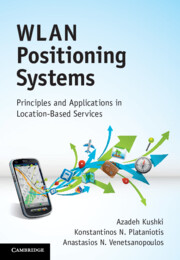6 - Memoryless positioning
from Part II - Signal processing theory
Published online by Cambridge University Press: 05 February 2012
Summary
The objective of a positioning system is to determine the position of a mobile device. This position, however, is not directly observable and must be determined based on some observable measurement. In the case of RSS-based positioning, this observable measurement is the received signal strength (RSS) at the mobile device. If the relationship between the RSS values and the position of mobile devices were known, the positioning problem would be trivial. However, as discussed in Chapter 5, this relationship is not deterministic in practice, but depends on the stochastic characteristics of the propagation environment. Consequently, the unknown position can only be estimated using RSS measurements. The focus of this chapter is the various estimation methods used to accomplish this task. In particular, this chapter focuses on memoryless estimators, which rely on an RSS measurement at a given time to compute the position estimate at that time. In other words, memoryless estimators do not consider the past history of user positions or RSS measurements during estimation.
We begin this chapter by developing a mathematical formulation of the memoryless positioning problem (Section 6.1) and show that this problem reduces to a density estimation problem. We next review two methods for density estimation based on the implicit training information provided in the radio map (Section 6.2). Using these density estimation techniques, we proceed to develop several position estimators (Sections 6.3 and 6.4). Finally, we conclude the chapter with the presentation of some experimental results (Section 6.5).
- Type
- Chapter
- Information
- WLAN Positioning SystemsPrinciples and Applications in Location-Based Services, pp. 68 - 91Publisher: Cambridge University PressPrint publication year: 2012



